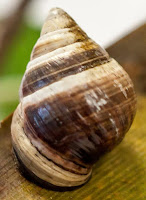 |
| Narwhal London Review of Books image |
It seems that
besides prompting myths, the narwhal’s tusk (a tooth that grows out through the
upper lip, twisting counter-clockwise) became a be-jeweled staff or a drinking
horn among royalty in the middle ages.
(Best not to ask what happened to the narwhal itself.)
That ancient lore leads to another denizen of the deep:
jellyfish -- regarded by some as ethereally beautiful and by others as rubbery
stinging creatures to be feared and avoided.
How about eating them: any takers?
Would it be “thanks” or “no thanks” from other sea residents? Till now, the assumption was that most
other ocean animals took a pass on eating jellyfish.
 |
| NYTimes image |
R.I.P. George
Then there’s the snail.
Once upon a time on earth, snails were prevalent; now -- as is the case
with many animals -- their presence has diminished. One variety native to the Hawaiian Island of Oahu
became extinct on Jan. 1 with the death of “George,” the thumbnail-size 14-year
old lone known survivor of the Achatinella apexfulva species.
 |
| George |
Tempting tortoise shells
Speaking of animal extinctions,
consider the radiated tortoise (possibly for the first time, I know!) -- once numbering
in the millions, but now looking extinction in the face within 20 years. Their high-domed shells have star patterns
that appeal to would-be pet owners all over; that fact was all wildlife poachers
and smugglers needed to know. They “collect”
tortoises in the forest of southern Madagascar (the island off the southeast
coast of Africa), then crate and ship them around the world.
 |
| Dodo image |
Two recent rescue operations freed thousands of the critically endangered tortoises hidden between steps in their illegal trafficking. But they can’t return to the wild unless their safety is assured, so some 23,000 rescued tortoises must be cared for till then.
Pity the Pitties
The various campaigns to change how people regard “pit bulls” can’t
claim victory yet. Despite all the efforts
to “rebrand” these dogs, whose reputation still prompts people to give them a
wide berth and assume the worst, pit bulls are still feared -- as well as
discriminated against.
The irony is that
“pit bull” isn’t even a specific breed -- that umbrella label covers “a variety
of purebred dogs as well as mixes that share characteristics but not DNA,”
according to an APCA official. And the
tragedy is that “pit bulls have the greatest intake and euthanasia rate at
shelters,” she adds.
CCD: sad but real
Canine cognitive decline, or CCD, is the name for what
can happen as pets grow older. (The human
equivalent is dementia.) Although CCD comes
with various signs -- soiling indoors, seeming anxious, changed sleep patterns,
meowing or barking for no apparent reason -- those signs can also signal health
problems.
A recent “Pets”
feature asked “Does your dog have dementia?” Happily, it includes numerous things pet parents
can do manage symptoms.
#
If you would like to comment on this blog post,
please go to 1moreonce.blogspot.com.

No comments:
Post a Comment